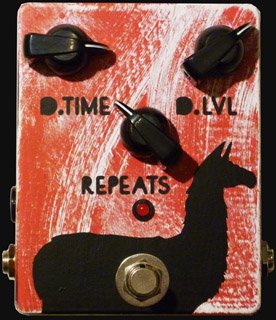By: Levi Clay
 I’m going to start this review with a generalization; I think that a guitarist never thinks his “tone” is good enough unless he feels happy about the gear he is using.
I’m going to start this review with a generalization; I think that a guitarist never thinks his “tone” is good enough unless he feels happy about the gear he is using.
Some players will only use a certain brand of strings, Eric Johnson is even famous for only using Duracell batteries in his pedals because he claims to hear the difference. I even have one friend who labels his leads ends “signal in” and “signal out” because he feels that over time the lead will become used to carrying signal in one direction.
Everyone will have opinions on the legitimacy of these claims, but one thing is for sure. If you feel that a certain brand of batteries sound good, you’ll never be happy using another brand.
The reason I’m telling you this is that I have to admit it, I am a gear snob. I get excited about hard to find expensive boutique gear. It’s not because I think I’m better than everyone else. It’s because I feel better about my sound when I’m using what I describe as “nice” gear.
Imagine my excitement then, when a good friend pointed me in the direction of Jam Pedals. A relatively new company hand making analogue pedals from the highest quality materials with rare NOS chips, matched NOS transistors and carbon-comp resistors.
Sounds like the things dreams are made of right? Add to this that they offer point-to-point wired versions of their line and custom paintjobs and finishes for that personal touch and that gear craving disease we all suffer from is again causing me to foam at the mouth.
******
The Delay Llama is billed as a fully analogue lo-fi delay using a faithful reproduction of the Panasonic MN3205 chip. Analogue delay is a highly desirable effect. The only word I can find for a good analogue delay is organic; it can breathe depth and warmth to your tone that many say the pristine digital delay units just don’t do.
Opening the box for the pedal reveals a silk paisley tie bag, very bohemian and giving it that instant vintage quality. You’re also given the instructions and a Jam pick. My first impression of the actual pedal is a good one.
The beautifully hand painted shell has a textured feel to it. This pedal just oozes that boutique look. It’s very reasonable size (120 x 94 x 30mm) means you shouldn’t have trouble finding space for this unit on your board.
As with most pedals in the line, simplicity is the order of the day here with just three knobs, delay time, delay level and repeats. Aside from this, we have a sturdy footswitch, an LED to show when the effect is engaged, an in and out socket and a 9v DC power adaptor input for those who use a BOSS style power supply (This is a big selling point for me as the Trex requires 12v).
The delay time knob gives us access to a maximum of 600ms delay time which isn’t a lot compared to some other units, but in my opinion is more than enough. And the repeats knob goes from a single repeat (for slapback sounds and the Albert Lee “Country Boy” effect) all the way up to infinite repeats.
As I have said previously I love vintage sounding effects so I was absolutely over the moon when I heard how lo-fi this delay is. The repeat degradation is enough to add some meat to your sound, unlike a digital delay which only seems to add ambience.
That being said, this pedals best feature is also its weakest point; some will consider the amount of decay too extreme. It is perfect when using the pedal to create medium length delay for leads but I can’t help but think the repeat can feel a little too warped when I rip out some Setzer riffs with a slapback sound.
It would have been nice to have the option to adjust the level of decay, but this pedal shouldn’t have eleven or so knobs, it’s not an eventide and I love it for that.
I sat playing with this pedal (using a SuhrGG into a Bogner XTC101b) and eventually got to the point when I forgot the delay was even on. I considered it a natural extension of my sound leaving me with the feeling that something I was missing when I turned it off.
Of course when we shift up the repeats to infinite we have the ability to tweak the dealy-time knob to create crazy computer game like sounds that never fail to turn heads.
My favourite settings would have to be with the repeats on 10 o’clock and the level at 11 o’clock. Then I adjust the delay time depending on the tempo of the song. This brings me to the other feature I feel this pedal would benefit from is a tap tempo, other companies like Trex and Carl Martin have taken advantage of this and I can’t really see a downside. Hopefully this feature will be incorporated in the future.
The quality of this pedal really isn’t under any scrutiny. There’s no questioning how unbelievably great this pedal sounds. What you need to decide is, “Would analogue delay be more suited to your playing than digital?” If the answer is yes then I really would say look no further because they don’t get much better than this!
At 230E ($290/£190) it’s not cheap and there’s plenty of competition, some of which have additional features. But, maybe the appeal of having a pedal with your own custom finish is enough to sell it to you.
For me, the sound speaks for itself. It will be a long time before this baby leaves my gigging board.